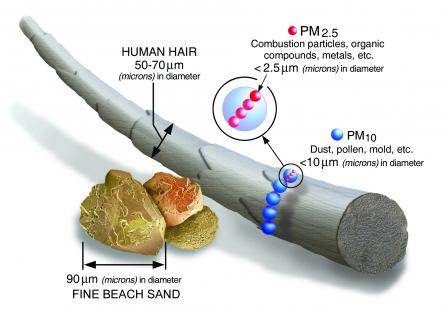Note: Lana Cohen is a Report For America fellow covering the environment & natural resources for TMV & KZYX. Her position is funded by the Community Foundation of Mendocino, Report for America, & our readers. You can support Lana’s work here or email [email protected]. Contact Cohen at LCohen@mendovoice.com. TMV maintains editorial control.
MENDOCINO Co., 9/16/20 — Today is the first day in nearly a month that there is decent air quality in large parts of Mendocino.
You probably don’t need to be told that the air quality in the county has fluctuated between bad to worse over the past few weeks, with parts of inland Mendocino consistently suffering through hazardous pollution. During his Friday COVID briefing, Dr. Anthony Coren, public health officer for Mendocino County, noted that Willits consistently had the worst air quality on earth during the heavier smoke days and the health impacts of the lingering smoke are potentially more serious than many of us may realize.
A medical doctor, scientist, and air quality specialist who we spoke to all said that an increase in pollution from smoke can cause serious, detrimental health impacts ranging from asthma to heart attack. Furthermore, the amount of air pollution from the wildfires burning up and down the West coast and the length of time that the smoke will likely stick around is exceptional.
“This is kind of an experiment, unfortunately, that’s going to get done on all of us,” said Dr. Brooks Kuhn, a pulmonary and critical care specialist at UC Davis.
Although this experiment is being done on all of us, the results may be especially harmful for people with preexisting conditions, children, and pregnant women.
“The pollutant levels have been hazardous to your health, for the most part,” said Anthony Wexler, Ph.D., who is director of the Air Quality Research Center at University of California Davis. When considering how bad the air quality might be, an instructive measure is visibility. “If your visibility is impaired by the smoke, then you shouldn’t be outside, because this is not good for your health.”
Visibility is an important bellwether, especially because there are so few air quality monitors in Mendocino County that can provide accurate air pollution data. With only three government issued monitors in the whole county, visibility is sometimes the only way to figure out if the air you’re breathing is safe.
Starting in August, smoke, largely from the August Complex fire, drifted west from Mendocino National Forest, sinking into the valleys and sticking around for days. Visibility plummeted and the sky turned an unsettling yellow to red, giving the world a dreamlike, amber hue. Last week, the major wind event which fanned the flames of the complex, decreased air quality and pushed plumes of smoke across the county. Hazardous pollution filled air reached well past the coastline and moved far out into the Pacific ocean.
One harmful kind of pollution that comes from wildfires is particle pollution, or particulate matter, which is a mixture of solid and liquid particles found in the air that can cause respiratory and heart problems. The particles can be made up of dust, dirt, soot, smoke, and hundreds of different chemicals. Two types of particle pollution are PM10 and PM2.5.
PM10, particulate matter less than 10 micrometers (10 microns), is visible to the naked eye. It’s the ash you see raining from the sky or coating your car in the morning. For reference, one micrometer is one millionth of a meter and a human hair is around 50 micrometers.

Particulate matter 2.5, on the other hand, is much smaller. PM2.5 is what causes the wall of haze that makes headlights necessary at noon and obstructs normal views. PM 2.5 is more dangerous than PM10. It’s size allows it to infiltrate deep into the lungs, or even bloodstream, which can potentially result in serious health problems.
The resounding message from everyone we spoke to was that the best way to stay safe in the face of extreme air pollution is to, when possible, stay indoors, keep the air conditioning running, and get an air filter. Health officials recommend to keep the AC on “recirculate,” if possible, so as not to suck in new polluted air from outside.
Although PM2.5 is dangerous for anyone who breathes it, it can be much more detrimental to certain sensitive groups.
“I kind of put people into three main bins — people with asthma, COPD [chronic obstructive pulmonary disease] or a heart condition of any type, children and pregnant women, and generally healthy people,” said Doctor Kuhn.
Kuhn explained that for people with serious heart or lung conditions, people in the first bin, air pollution can aggravate symptoms and be directly detrimental, or even fatal, to their health. “They should, as much as possible, not go outside,” said Kuhn.
For children and pregnant women, the health concern is more long term. Kuhn explained that breathing air polluted by wildfire smoke before the lungs are fully developed, which, for most people, is not until their mid 20s, can cause the lungs to grow improperly. This can result in diminished lung function and an inclination towards lung disease as an adult.
For generally healthy adults, the potential health impact of wildfire smoke is both long term and variable.
“Breathing in wood smoke from fires is like smoking cigarettes, because the cigarettes are also burning leaves,” said Wexler. “Concentrations aren’t as high, but you’re breathing the polluted air all the time. For people with normal health, it’s probably not a big deal in the short term, but it may cause problems in the future,” said Wexler.
Wexler went on to explain that like with smoking cigarettes, breathing in wildfire smoke could potentially result in a wide range of health problems down the line, from asthma to cancer.
One factor that may increase the potential of adverse health effects due to wildfire smoke is length of exposure. “The amount of smoke, the amount of poor air quality, and the time that we’re all gonna be unfortunately exposed to this is profound,” said Kuhn. “Even comparing back to the Carr and Camp Fires that we experienced two years ago. This is a lot more and a lot longer.”
Scientific literature shows that there is a relationship between long term exposure to PM2.5 and lung disease. A study found that when there was an increase of pollutants (PM2.5), there was also an increase in mortality.
More specifically, for every microgram per cubic meter increase in PM2.5, there was a two percent increase in mortality, according to information from a June 2020 study published in peer reviewed medical journal, PLOS Medicine.
The study took place in Queensland, Australia, where the average particulate matter ranged between 1.6 to 9 micrograms per cubic meter. Over the past month in some areas of Mendocino County, air quality has largely ranged between roughly 33.5 and 425 micrograms per cubic meter of PM2.5.
According to the air quality index from Air Now, a partnership of government organizations that records air quality data, air quality has fluctuated between good to hazardous . On the index, air quality is divided into six groups: good, moderate, unhealthy for sensitive groups, unhealthy, very unhealthy, and hazardous.
Good air quality starts at 0 on the index, which is also 0 micrograms per cubic meter (µg/㎥) of PM2.5. Moderate air quality starts at 51 on the index, or 12.1 µg/㎥ of PM2.5. Air quality that is unhealthy for sensitive groups begins at 101, which is equivalent to 33.5 µg/㎥ of PM2.5. Air quality denoted by the index as unhealthy, begins at 151, or 55.5 µg/㎥ of PM2.5. Very unhealthy, or 201, is 150.5 µg/㎥ of PM2.5, and hazardous, or 301, begins at 250.5 µg/㎥ of PM2.5. The hazardous section of the index tops out at 500 on the scale, or 500.4 µg/㎥ of PM2.5. Concentrations of PM2.5 in the air can get above 500.4 µg/㎥, but there Air Now does not have a category higher than hazardous.
Air Now has a calculator feature on their website where their air quality index numbers can be translated into micrograms per cubic meter of specific pollutants. You can also use the Air Now website to look at current air quality and recent trends where you live by typing in your zip code.
In the past month, Willits topped out at 456 on the air quality index (AQI), or 433.7 µg/㎥ of PM2.5, on September 9th. Ukiah reached 178 on the AQI, 107.7 µg/㎥ of PM2.5, on August 28th. Fort Bragg reached 110 on the AQI, equivalent to 39.1 µg/㎥ PM2.5.
Kuhn is very concerned about the potential long term health impacts of this unprecedented situation of extremely poor air quality that is likely to continue for an extended period. “There is nothing to compare this to,” he said.
Another issue is that official government run air quality monitors are few and far between, literally. There are very few air quality monitors, largely because they are expensive to buy and upkeep, and the distance between them is great. This makes it challenging to accurately track air quality.
In Mendocino County, there are only three permanent sensors, one in Fort Bragg, one in Willits, and one in Ukiah. This makes it impossible to find verified air quality data in other areas, such as in Anderson Valley, or in Covelo, which may be experiencing worse air quality than even Willits from the August Complex.
According to air monitoring specialist from the Mendocino County Air Quality Management District, Warren Massie, who spoke to Mendocino Voice publisher Kate B. Maxwell, the county could request more sensors. The sensors each cost around $20,000 at the outset. That does not include the cost for housing the device, which needs to be in a climate controlled environment, and upkeep. The county would be responsible for all costs.
Another option is lower cost Purple Air sensors. Massie said the county has purchased and placed a few purple air sensors in Mendocino, including in Potter Valley. However, the data from purple air sensors is not verified, unlike the Air Now data, which is verified by government agencies including the United States Environmental Protection Agency (EPA) and the National Oceanic and Atmospheric Administration (NOAA).
Although some scientists believe that Purple Air is less reliable than Air Now, the National Weather Service Eureka office advised people to use it in a pinch.
In addition those with preexisting conditions, women, and children, there is one more group, or bin, of people that are especially at risk of being harmed by poor air quality. “The biggest thing that has me worried is people of low socioeconomic status,” said Kuhn. “Previous data shows that, especially our homeless population, or people who can’t get inside of air conditioning, I think they’re gonna get hit the heaviest. There’s just nowhere to hide.”







I’ve been comparing the AirNow and PurpleAir readings for close to a year across all of Northern California. AirNow doesn’t even come close in terms of accuracy because its readings are averaged over many hours. Also, a lot of the USG sensors are old and quite possibly not calibrated properly – I doubt it’s a high priority for this administration. So I’m glad to see the county placing PurpleAir sensors. Not too costly and very helpful!
There are preventative measures to take to alleviate our lungs from inhaled toxins: drinking herbals teas and tinctures such as mullein, licorice, lobelia, mints, etc. can help dispel mucus (check out the Mendocino Herb Guild for their herb recommendation and tea blends at the farmers market), steaming with eucalyptus and peppermint, eliminating inflammatory foods from our nutrition like dairy, eat more supporting foods for the digestive tract. Media news needs to integrate positivity more, less fear mongering.
I was extremely short of breath due to my Emphysema, partly because of the air polution.. I was introduced to VineHealth Center and their COPD Herbal Protocol. I started on the COPD Treatment last year, my symptoms gradually diminished including my shortness of breath, wheezing and fatigue. Reach the m at vinehealth center. c om